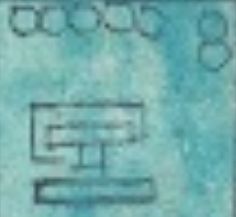Chicome Calli (Mdz2r)
This simplex glyph plus notation represents the solar year (xihuitl) Chicome Calli (Seven House, or 7-House). It includes a house with the typical right angles and T-shaped wooden framing around the entry way. It is shown in profile, facing the viewer's right. The notation for seven consists of two groups of ones, five across the top, and two ones down the right side. The entire year date is painted turquoise blue. The date is boxed in the original, although this image fails to capture the outline of the box.
Stephanie Wood
The color name (xihuitl) is a homophone for the word for year (also xihuitl). The boxing in is also typical for dates. The grouping of the ones in the notation recall the ancient system of counting on fingers and toes. It also results in a math equation: 5 + 2 = 7.
Joaquín Galarza argued that this standard sign for calli was half of a building. But, if we flipped the building over and joined the two pieces together, the beam across the top would not be continuous given the roof overhang at the end of the horizontal beam.
Stephanie Wood
c. 1541, or by 1553 at the latest
Stephanie Wood
xiuhpohualli, año, turquesa, xihuitl

acalli, ship, boat, https://nahuatl.wired-humanities.org/content/acalli
chicome, seven, https://nahuatl.wired-humanities.org/content/chicome
Codex Mendoza, folio 02 recto, https://digital.bodleian.ox.ac.uk/objects/2fea788e-2aa2-4f08-b6d9-648c00..., image 14 of 188.
The Bodleian Libraries, University of Oxford, hold the original manuscript, the MS. Arch. Selden. A. 1. This image is published here under the UK Creative Commons, “Attribution-NonCommercial-ShareAlike 3.0 License” (CC-BY-NC-SA 3.0).
